
As more companies continue to lay off a significant portion of workers, reductions-in-force are leaving remaining employees feeling isolated, guilty, and disengaged, known as “workplace survivor syndrome.”
In fact, nearly three-quarters of layoff survivors felt their work motivation declined after layoffs, according to a 2022 survey from Bizreport. The same survey found that over half of layoff survivors felt overworked and, a similar number were less likely to recommend their organization as a great workplace after a layoff.
As hard as layoffs can be for an organization – with negative effects on everything from culture to productivity – they are sometimes a necessary part of an organizational life cycle. However, not properly handling the layoff and nurturing the organization after it has been conducted can lead to negative consequences, including workplace survivor syndrome. Here’s how to recognize and mitigate it.
What is workplace survivor syndrome?
After an organization goes through a layoff, employees who remain at the company can be affected by workplace survivor syndrome, which describes the psychological effects of a layoff on employees who stay in the organization. Workplace survivor syndrome can cause a range of negative emotions related to the shock and guilt of witnessing colleagues lose their job.
An employee who is suffering from workplace survivor syndrome may experience:
- Depression
- Anxiety
- Guilt
For anyone, witnessing and experiencing the fallout of a layoff can harm well-being. Workplace survivor syndrome often impacts employees who see team members or adjacent-level employees being let go due to layoffs or downsizing. Remaining employees who are expected to get back to “business as usual” – and may even end up taking on a larger workload due to workforce reductions – can be left without support from the organization.
These effects after a layoff can be amplified in fully remote workforces due to certain aspects of remote work, including less job security and lack of face-to-face connection.

Signs of survivor syndrome in the workplace
Although there are some specific emotions that employees may be experiencing with survivor syndrome, it isn’t easy to gather the internal feelings of employees. In fact, many employees may try to intentionally mask symptoms of survivor syndrome for fear of losing their job.
However, feelings of depression, anxiety, and guilt can manifest into different employee behaviors, which can help give you a clue into employees who may need support.
An employee who’s suffering from workplace survivor syndrome may experience:
- Reduction in focus and productivity
- Higher rates of absenteeism due to mental or physical symptoms
- Instances of emotional volatility
It’s important to remember that survivor syndrome can manifest in various ways depending on several factors, and the symptoms can also indicate a different employee well-being issue, so it’s important to investigate the issue further to help get employees the help they need.
How to mitigate survivor syndrome
Being able to identify symptoms of workplace survivor syndrome is only half the battle. In fact, by the time the effects of survivor syndrome start presenting at work, it can already cause issues across the organization.
That’s why it’s important to take steps to mitigate issues before and during a layoff.
Here are a few ways to mitigate workplace survivor syndrome during a layoff:
- Transparent communication: HR can embrace transparency and open communication through any changes in workplace structure, including layoffs or downsizing, to help prepare employees and the organization as a whole for changes.
- Acknowledge impact: Managers and leaders can acknowledge the emotional impact of a layoff with remaining employees to help facilitate communication and help encourage employees to check in with themselves and validate their own emotions.
- Redefine roles and responsibilities: To reduce employee burnout and make any symptoms of survivor syndrome worse, leaders should strategically redefine roles and responsibilities after a layoff to manage workloads and set expectations.
- Foster a positive culture: It’s up to the entire organization – managers, HR, leaders, and peers – to foster a positive work culture to help build resiliency and prepare for sudden workforce changes such as a layoff.
- Enhance well-being: HR can enhance well-being initiatives during times of change to help employees prioritize well-being and reduce the effects of survivor syndrome.
Best practices to help employees
Employees with workplace survivor syndrome who do not get the support they need can lead to issues like disengagement and turnover.
If you notice an employee is suffering from survivor syndrome, consider some of these best practices to help them work through it:
- Offer resources through an EAP
- Provide career development opportunities
- Consider an Employee Resource Group for those struggling
- Give employees an adjustment period
- Monitor progress with employee surveys and feedback opportunities, such as one-on-one meetings
One of the most important practices when trying to mitigate survivor syndrome is clear and open communication.

Many companies, such as Stripe and Airbnb, provide great examples of clear communication, including:
- The reason for layoffs
- What the path ahead may look like, and
- Acknowledgment of emotional impact on those being laid off and those remaining with the organization.
Just as employees can have a difficult time dealing with layoffs, HR and management can also experience the negative effects of a layoff, including facilitating difficult conversations, making choices about who will be laid off, and dealing with the guilt of a layoff after it happens. During this time, HR, management, and other leaders in the organization must take time to recharge themselves with self-care activities to help them appropriately deal with these emotions.
More on people practices: Identity why your employees are buddy punching
